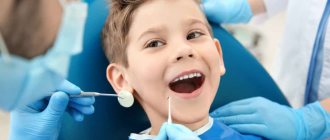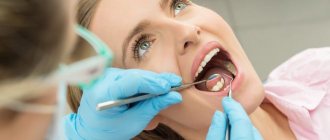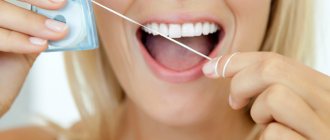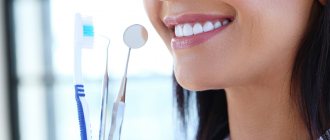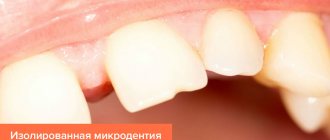Anna Andreevna Bespalova, a dentist-therapist at the Denta-El clinic, talks about what procedures are necessary to prevent and protect against oral diseases, as well as how to effectively combat diseases such as caries, stomatitis, etc.
It is common knowledge that poor oral hygiene is the root cause of all problems. However, not everyone understands why hygiene is so important. Without constant care, accumulations of plaque (at first soft) form in the mouth, becoming an ideal breeding ground for bacteria.
They digest plaque and release acids that negatively affect teeth. The layers of calcium are washed away and the enamel dissolves, becoming brittle. As a result, so-called demineralization of the enamel is observed, which ultimately leads to the formation of caries.
In childhood, this often manifests itself as white (sometimes yellow) spots on the teeth on the front side. The next stage after this is caries.
Tartar
Tartar is a soft plaque that has been in the mouth for so long that it has hardened to such an extent that it seems to “ stick ” to the tooth. At the same time, in addition to difficulties with hygiene, the stone can cause inflammation of the marginal gum - swelling and bleeding, causing constant discomfort. As a result, children try to avoid inflamed areas when brushing their teeth.
The result of this process is gingivitis and stomatitis , and in advanced cases, gum atrophy occurs along with exposure of the dental necks. The sensitivity of teeth to temperature and other influences increases significantly .
Contraindications
Professional teeth cleaning with Air Flow is not carried out if the child has a fever, a stuffy nose or other signs of a cold. It is also contraindicated:
- with exacerbation of chronic diseases;
- inflammation of the oral mucosa;
- pathologically low strength of teeth (demineralization);
- deviations in the structure of teeth and their hypersensitivity;
- the presence of severe diseases of the cardiovascular and endocrine systems;
- respiratory diseases;
- AIDS, hepatitis.
The hypoallergenic composition of the cleaning solution, which is used during cleaning, usually does not cause a negative reaction in children. But if the child is prone to allergies, the doctor must be informed about this in advance.
How to remove plaque
Removing soft and hard plaque from teeth seems to be an elementary procedure, but, nevertheless, it requires the specialist, in addition to attention, to have some experience in such operations . The soft coating is removed with special rubber bands (or a brush). As a rule, children do not object to this - they do not experience discomfort or pain as a result of the procedure . But the importance of such a procedure is difficult to overestimate - despite its apparent simplicity, it can become an important preparation for subsequent treatment, accustoming the child to manipulations in the oral cavity.
In the case of tartar, special devices - ultrasonic or manual.
Fissure sealing
Fissures are grooves on the chewing surface of the tooth that separate the chewing cusps.
Most often, caries forms on fissures and interdental spaces. At 6–7 years of age, children’s permanent chewing teeth erupt, but the enamel in the fissure area has not yet fully formed. Fissures become a vulnerable place for caries. Food debris gets stuck in them and causes caries, especially carbohydrates.
To avoid this, a sealing procedure can help. Sealant is a liquid filling material. It fills all the cavities on the surface of the tooth and creates a barrier for bacteria. Sealants seal fissures, nourish the enamel with fluoride and help it form healthy.
How is fissure sealing performed?
- First, the tooth is thoroughly cleaned of plaque.
- If necessary, the doctor “opens” the fissures.
- If the fissure is deep and narrow, the doctor can widen it with the smallest bur. This way the material will be better distributed throughout the fissure.
- After preparing the tooth, the fissure is filled with sealant and illuminated with a photopolymer lamp for 40 seconds.
- The tooth is polished and coated with a protective varnish containing fluoride.
The procedure takes 30 minutes. In one visit, you can seal the fissures of all chewing teeth. Anesthesia is not needed for the procedure, because the deep tissues of the tooth are not affected.
At the Denta Vi dental clinic in Yekaterinburg, a pediatric dentist is attending.
We treat caries in children, straighten the bite and carry out caries prevention. Remember to bring your child to the doctor regularly for preventive examinations to maintain the health of his teeth and the beauty of his smile. We will advise you on the rules of caring for children's teeth and give all the necessary recommendations. Make an appointment
Frequency and periodicity of professional hygiene
Of course, the frequency of professional cleaning is different for each child , and depends mainly on the quality of dental care - some children brush their teeth so well that they can only be taken to a specialist annually, while others ...
When undergoing orthodontic treatment, crowded teeth or poor hygiene, preventive maintenance and professional cleaning should be performed as often as possible .
Do not underestimate the importance of professional cleaning - after all, during it, the doctor will not only teach the child how to properly care for his teeth, but will also select individual products or medications - this is especially important for various diseases or defects of the oral cavity. For example, if there is crowding, a regular toothbrush is not very effective; in this case, the child needs a special brush.
When to start brushing your child's teeth
It is necessary to monitor your child’s oral hygiene from the appearance of the first tooth. At first, the cleaning process resembles more of a gum massage. For these purposes, a silicone cap with soft bristles is used, which one of the parents puts on the finger. This procedure greatly facilitates teething, which is often accompanied by severe itching. In addition, from an early age, the baby gets used to hygienic oral care on a subconscious level.
From about 2–3 years old, a child learns to brush his teeth independently. But at this age he still cannot completely eliminate plaque, so adults should help him with this and control the process. However, by age 4, many children have blackened teeth, multiple cavities, and other dental problems. Professional cleaning will help prevent decay and premature loss of teeth.
Features of professional oral hygiene
Oral hygiene in children three to five years old
- removal of plaque and plaque using rotary brushes (using low-abrasive pastes);
- floss polishing
- remineralizing therapy (local, using gels and jellies).
Oral hygiene in children six to ten years old
- determination of quality of care ( plaque markers
- regular teeth cleaning under the supervision of a specialist;
- hygiene index – the quality of the child’s teeth brushing, his mistakes;
- training in proper cleaning;
- repeated cleaning under the supervision of a specialist, taking into account her recommendations;
- removal of plaque and plaque using rotary brushes (using low-abrasive pastes);
- polishing with rubber heads and paste; strips (strips);
- remineralizing therapy (office or at home);
- local fluoridation using gels, jellies or varnishes.
Oral hygiene in adolescents aged eleven to sixteen
- removal of plaque and plaque using rotary brushes (using low-abrasive pastes and air-abrasive devices). For mineralized deposits - cleaning with ultrasonic tips ;
- periodontal soft tissue indices. If symptoms of inflammation are detected, anti-inflammatory treatment is carried out;
- remineralizing therapy (at the dentist or at home).
What is dental plaque: why does it appear?
It is generally accepted that only adults need professional dental hygiene. That dense plaque forms only on permanent permanent teeth. However, plaque formation does not depend on age. Moreover, in children some processes occur faster.
The reason for the unaesthetic and foul-smelling film on the teeth is the active work of pathogenic bacteria - their reproduction, growth, and death. If thin plaque is not cleaned off at the initial stage, it will grow, thicken, and move from the dental crown deep under the gum.
Basic personal hygiene mistakes
- the procedure is performed too quickly ;
- cleaning occurs before eating ;
- no intermediate hygiene during the day (after meals);
- incorrect cleaning method. It is necessary to clean your teeth from all sides;
- insufficient care for hard-to-reach places - oral care methods
- poor selection of hygiene products. They also need to be constantly replaced with new ones;
- abuse of bleaching pastes based on peroxide compounds (usually with increased abrasive properties). This leads to the spread of pathogens .
All these mistakes often result from a lack of awareness among children and parents themselves about proper oral hygiene. To avoid this, regular consultations with an orthodontist are necessary.
How children's teeth are brushed
Not all types of professional hygiene are allowed for children. For example, ultrasonic cleaning is prohibited for children under 14 years of age. They act too aggressively on thin children's enamel.
The most gentle and effective option is considered to be Air Flow teeth cleaning, which translated from English means “air flow”. It got its name due to its execution technique.
The procedure takes place in several stages:
- The doctor conducts a visual examination of the child’s oral cavity to assess its condition and make sure there are no contraindications.
- The lips of the little patient are lubricated with Vaseline, preventing them from drying out.
- A protective cap and glasses, which are put on the baby before cleaning, protect the hair and eyes from getting fine powder.
- A saliva ejector is inserted into the mouth to remove excess fluid and saliva.
- A stream of air with a mixture of water and soda is supplied under high pressure from a special device with a thin tip. Flavorings added to the composition make brushing teeth more enjoyable for children. The doctor adjusts the pressure so as not to damage the child’s enamel.
- Circular movements remove all types of plaque from the cervical area (gum pockets), interdental space and other hard-to-reach places.
- At the end of the procedure, a strengthening fluoride varnish is applied to each tooth.
After cleaning Air Flow, it is recommended to refrain from eating for two hours. On the first day, the menu should include dishes of a soft consistency. You also need to exclude for a couple of days foods and drinks with coloring properties - beets, berries, black tea, juices.
Important! Be sure to change your toothbrush after the procedure, since using an old one can lead to re-infection.
Gum care in the first months of life
The first six months of life is the period when microbes populate the child’s mouth , which means that there is an increased likelihood of diseases - caries, stomatitis, infantile thrush, etc. Parents and other relatives often cause such diseases by transmitting germs to the baby through kisses, pacifiers, dishes and neglect to wash objects with boiled water. To minimize the risk, your child should wipe their gums with special wipes or finger tips every time after eating.
Cleaning baby teeth
Children should brush their baby teeth with a special brush for babies . At the beginning, the cleaning time should be 15-20 seconds , then the duration should be gradually increased . The most difficult thing at this moment, of course, is to arouse the child’s interest in this boring activity, from his point of view.
There are two methods as old as the world that have never lost their effectiveness:
- Turn hygiene training into a game - what little kid wouldn't love a flying spaceship brush or a superhero protecting his teeth? If the child is interested, he will voluntarily let his teeth be brushed and wait until the procedure is over. Perhaps even patiently.
- teach a child to do like mom or dad - children love to repeat after their parents. This feature can easily be used in the process of teaching children how to brush their teeth. Doing this with your child every day, you will find that your baby himself is demanding that the ritual be continued. The most important thing is that the pasta is to your taste .
It happens that toothpaste and brushes are simply not nearby, then dentists recommend chewing gum without sugar or a more traditional and healthy option - chewing an apple .
Prerequisites for the rapid formation of plaque on children's teeth
- A small amount of solid food in the child's menu - modern children gravitate towards soft food that does not require active chewing. Even fruits and vegetables are served to children in the form of purees or finely chopped.
- A large amount of sweets in a preschooler’s diet – carbohydrate foods accelerate the growth of bacteria.
- The thin enamel of baby teeth is quickly destroyed, which contributes to the strong fixation of plaque on the teeth and the spread of the film.
- Poor daily care. Preschool children themselves do not brush their teeth well, and parents do not always remember the need to control the quality of daily hygiene.
- Frequent colds and taking antibiotics worsen the bactericidal effect of saliva, which is important for the natural removal of dental plaque.
- Lack of microelements - fluorine, calcium.
